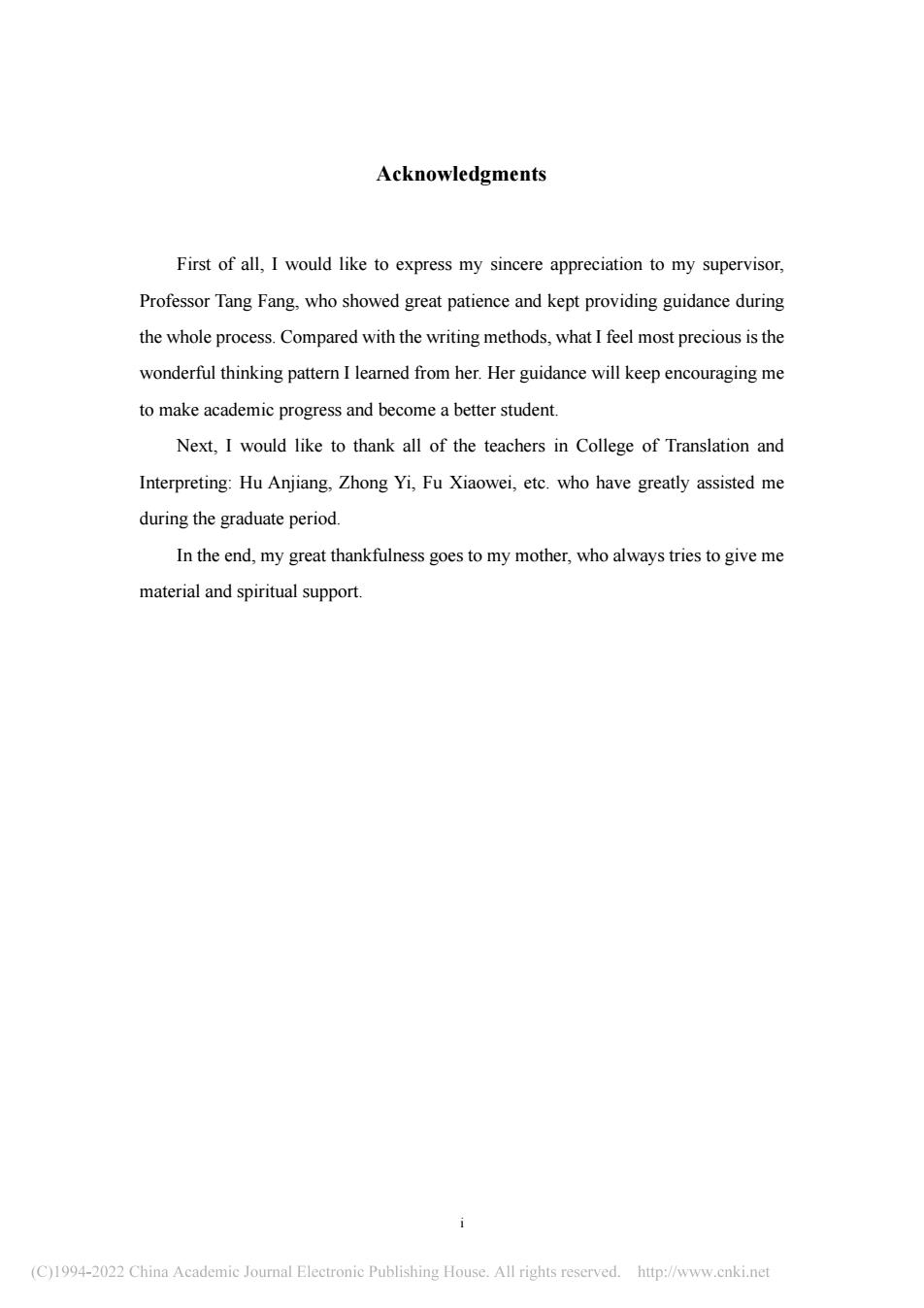
Acknowledgments First of all,I would like to express my sincere appreciation to my supervisor, Professor Tang Fang,who showed great patience and kept providing guidance during the whole process.Compared with the writing methods,what I feel most precious is the wonderful thinking pattern I learned from her.Her guidance will keep encouraging me to make academic progress and become a better student. Next,I would like to thank all of the teachers in College of Translation and Interpreting:Hu Anjiang.Zhong Yi,Fu Xiaowei,etc.who have greatly assisted me during the graduate period. In the end,my great thankfulness goes to my mother,who always tries to give me material and spiritual support. C)1994-2022 China Academie Joumal Electronie Publishing House.All rights reserved.http://www.enki.net
i Acknowledgments First of all, I would like to express my sincere appreciation to my supervisor, Professor Tang Fang, who showed great patience and kept providing guidance during the whole process. Compared with the writing methods, what I feel most precious is the wonderful thinking pattern I learned from her. Her guidance will keep encouraging me to make academic progress and become a better student. Next, I would like to thank all of the teachers in College of Translation and Interpreting: Hu Anjiang, Zhong Yi, Fu Xiaowei, etc. who have greatly assisted me during the graduate period. In the end, my great thankfulness goes to my mother, who always tries to give me material and spiritual support
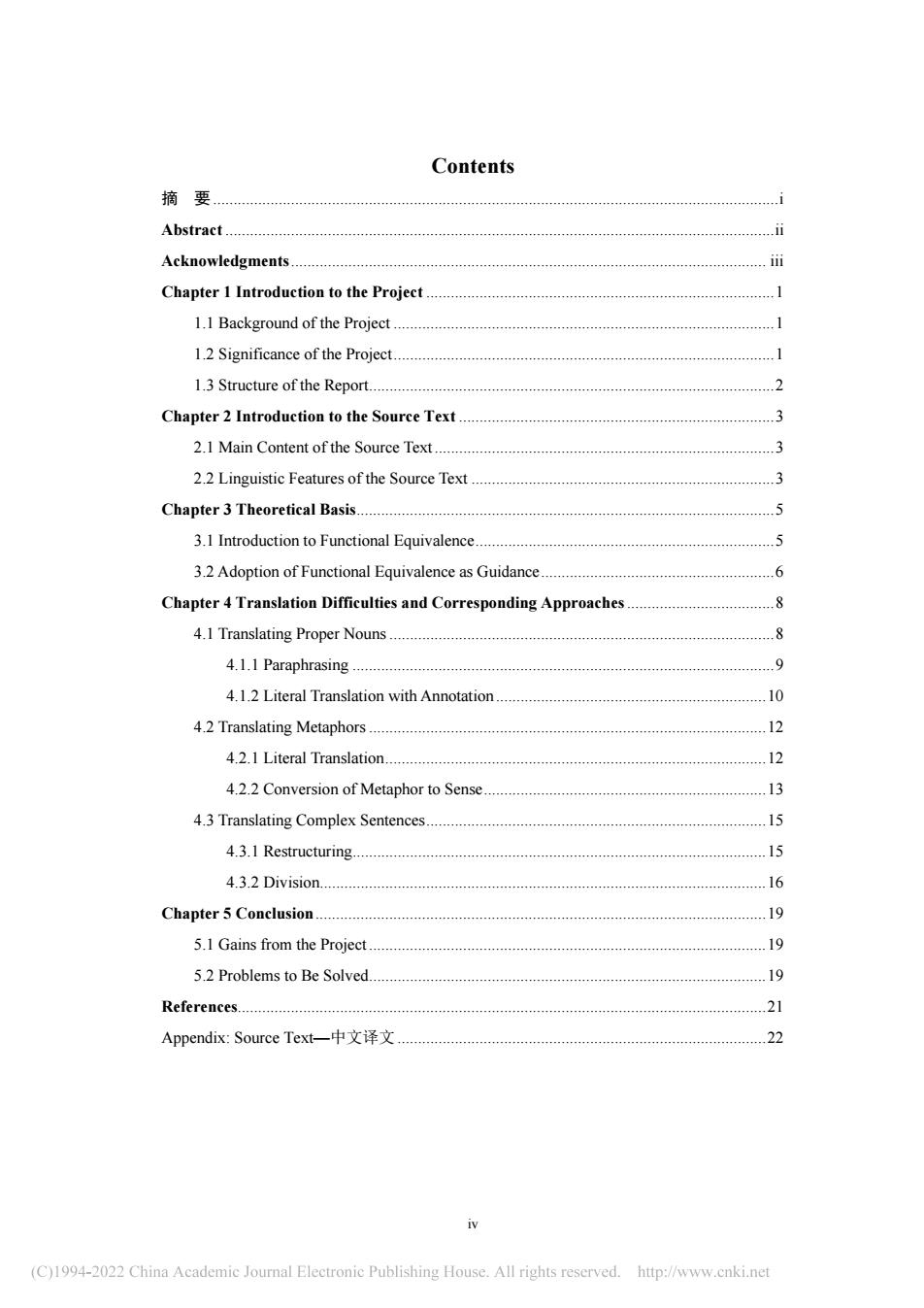
Contents 摘要」 Abstract Chapter 1 Introduction to the Project. 1.1 Background of the Project. .1 1.2 Significance of the Project. 1.3 Structure of the Report. .2 Chapter 2 Introduction to the Source Text 2.1 Main Content of the Source Text. 2.2 Linguistic Features of the Source Text. 3 Chapter 3Theoretical Basis. 5 3.1 Introduction to Functional Equivalence. 32 Adoption of Functional Equivalence as Guidance6 Chapter 4Translation Difficulties and Corresponding Approaches. 8 4.1 Translating Proper Nouns 8 4.1.1 Paraphrasing 4.1.2 Literal Translation with Annotation. .10 42 Translating Metaphors 4.2.1 Literal Translation 12 4.2.2 Conversion of Metaphor to Sense. 13 4.3 Translating Complex Sentences. 4.3.1 Restructuring. 15 Chapter 5 Conclusion. 19 5.1 Gains from the Project 19 5.2 Problems to Be Solved. .19 References. n21 Appendix:Source Text-中文译文 22 (C)1994-202 China Academie Joumal Electronie Publishing House.All rights reserved.http://www.enki.net
iv Contents 摘 要 . i Abstract . ii Acknowledgments . iii Chapter 1 Introduction to the Project . 1 1.1 Background of the Project . 1 1.2 Significance of the Project . 1 1.3 Structure of the Report . 2 Chapter 2 Introduction to the Source Text . 3 2.1 Main Content of the Source Text . 3 2.2 Linguistic Features of the Source Text . 3 Chapter 3 Theoretical Basis . 5 3.1 Introduction to Functional Equivalence . 5 3.2 Adoption of Functional Equivalence as Guidance . 6 Chapter 4 Translation Difficulties and Corresponding Approaches . 8 4.1 Translating Proper Nouns . 8 4.1.1 Paraphrasing . 9 4.1.2 Literal Translation with Annotation . 10 4.2 Translating Metaphors . 12 4.2.1 Literal Translation . 12 4.2.2 Conversion of Metaphor to Sense . 13 4.3 Translating Complex Sentences . 15 4.3.1 Restructuring . 15 4.3.2 Division . 16 Chapter 5 Conclusion . 19 5.1 Gains from the Project . 19 5.2 Problems to Be Solved . 19 References . 21 Appendix: Source Text—中文译文 . 22
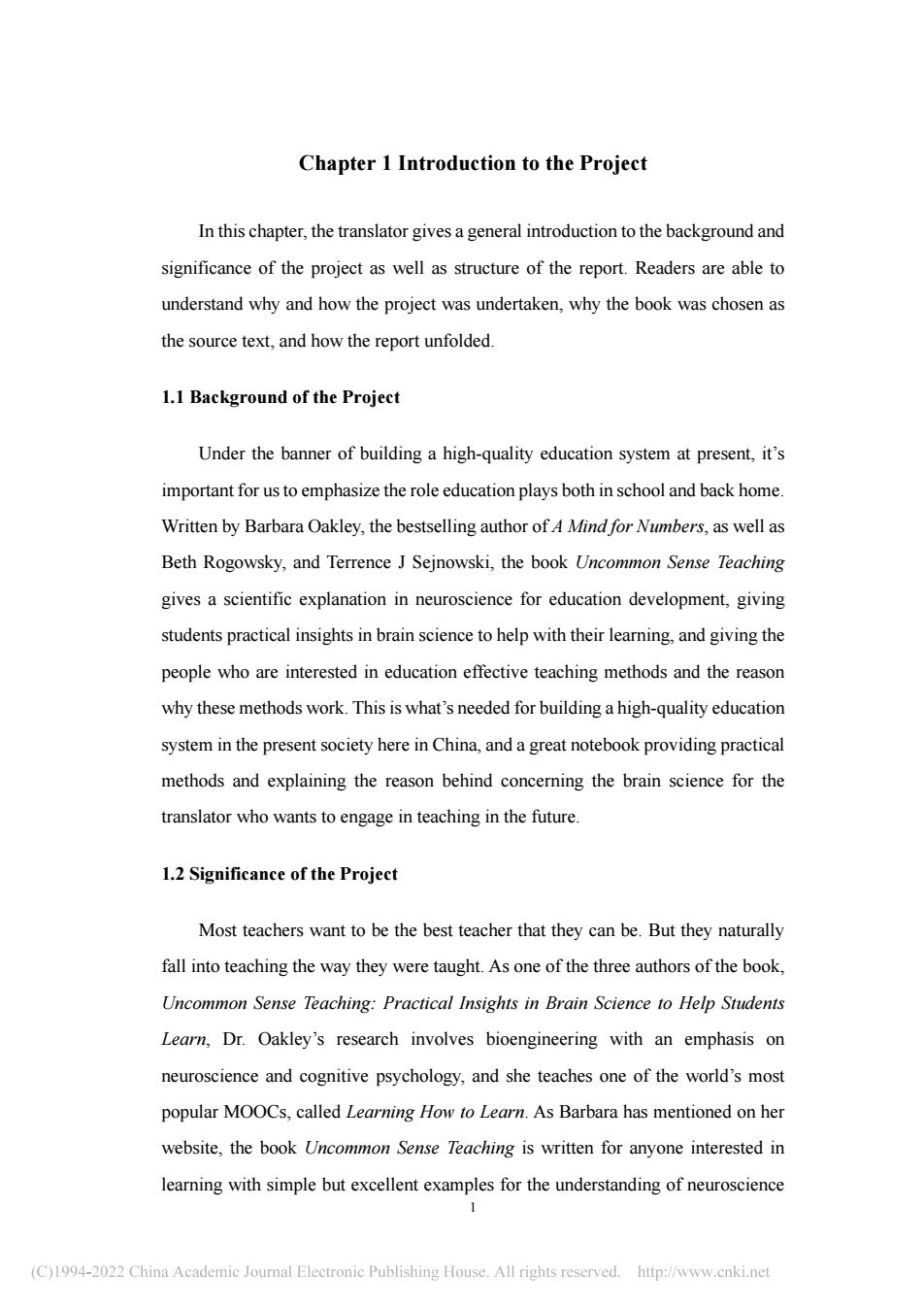
Chapter 1 Introduction to the Project In this chapter,the translator gives a general introduction to the background and significance of the project as well as structure of the report.Readers are able to understand why and how the project was undertaken,why the book was chosen as the source text,and how the report unfolded 1.1 Background of the Project Under the banner of building a high-quality education system at present,it's important for us to emphasize the role education plays both in school and back home Written by Barbara Oakley,the bestselling author of A Mind for Numbers,as well as Beth Rogowsky,and Terrence J Sejnowski,the book Uncommon Sense Teaching gives a scientific explanation in neuroscience for education development,giving students practical insights in brain science to help with their learning.and giving the people who are interested in education effective teaching methods and the reason why these methods work.This is what's needed for building a high-quality education system in the present society here in China,and a great notebook providing practical methods and explaining the reason behind concerning the brain science for the translator who wants to engage in teaching in the future 1.2 Significance of the Project Most teachers want to be the best teacher that they can be.But they naturally fall into teaching the way they were taught.As one of the three authors of the book, Uncommon Sense Teaching:Practical Insights in Brain Science to Help Students Learn,Dr.Oakley's research involves bioengineering with an emphasis on neuroscience and cognitive psychology,and she teaches one of the world's most popular MOOCs,called Learning Howto Learn.As Barbara has mentioned on her website,the book Uncommon Sense Teaching is written for anyone interested in learning with simple but excellent examples for the understanding of neuroscience (C)1994-2022 China Academie Joural Electronie Publishing House.All rights reserved.http://www.enki.net
1 Chapter 1 Introduction to the Project In this chapter, the translator gives a general introduction to the background and significance of the project as well as structure of the report. Readers are able to understand why and how the project was undertaken, why the book was chosen as the source text, and how the report unfolded. 1.1 Background of the Project Under the banner of building a high-quality education system at present, it’s important for us to emphasize the role education plays both in school and back home. Written by Barbara Oakley, the bestselling author of A Mind for Numbers, as well as Beth Rogowsky, and Terrence J Sejnowski, the book Uncommon Sense Teaching gives a scientific explanation in neuroscience for education development, giving students practical insights in brain science to help with their learning, and giving the people who are interested in education effective teaching methods and the reason why these methods work. This is what’s needed for building a high-quality education system in the present society here in China, and a great notebook providing practical methods and explaining the reason behind concerning the brain science for the translator who wants to engage in teaching in the future. 1.2 Significance of the Project Most teachers want to be the best teacher that they can be. But they naturally fall into teaching the way they were taught. As one of the three authors of the book, Uncommon Sense Teaching: Practical Insights in Brain Science to Help Students Learn, Dr. Oakley’s research involves bioengineering with an emphasis on neuroscience and cognitive psychology, and she teaches one of the world’s most popular MOOCs, called Learning How to Learn. As Barbara has mentioned on her website, the book Uncommon Sense Teaching is written for anyone interested in learning with simple but excellent examples for the understanding of neuroscience
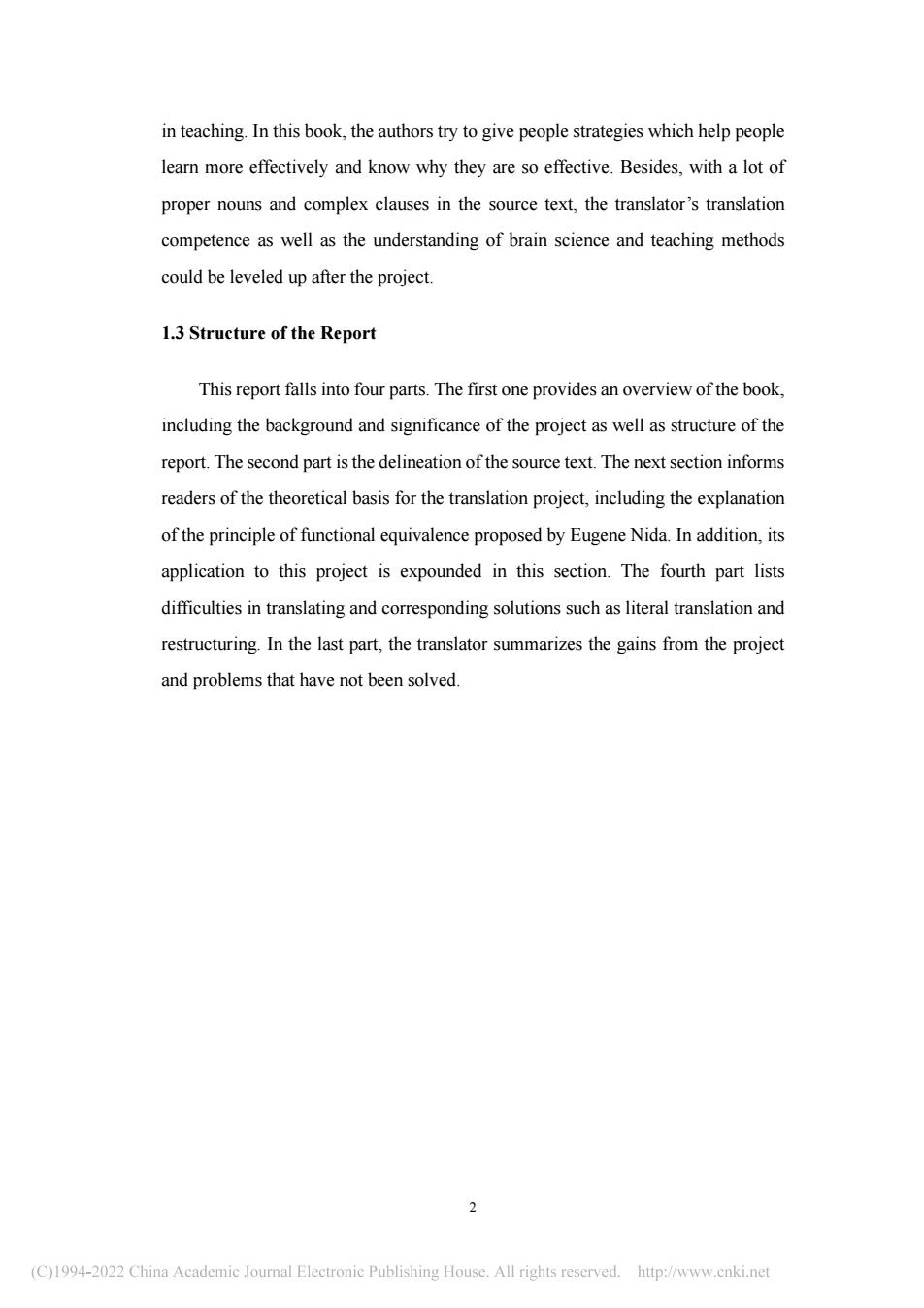
in teaching.In this book,the authors try to give people strategies which help people learn more effectively and know why they are so effective.Besides,with a lot of proper nouns and complex clauses in the source text,the translator's translation competence as well as the understanding of brain science and teaching methods could be leveled up after the project. 1.3 Structure of the Report This report falls into four parts.The first one provides an overview of the book, including the background and significance of the project as well as structure of the report.The second part is the delineation of the source text.The next section informs readers of the theoretical basis for the translation project,including the explanation of the principle of functional equivalence proposed by Eugene Nida.In addition,its application to this project is expounded in this section.The fourth part lists difficulties in translating and corresponding solutions such as literal translation and restructuring.In the last part,the translator summarizes the gains from the project and problems that have not been solved. 2 (C)1994-022 China Academie Jourmal Electronie Publishing House.All rights reserved.http://www.enki.net
2 in teaching. In this book, the authors try to give people strategies which help people learn more effectively and know why they are so effective. Besides, with a lot of proper nouns and complex clauses in the source text, the translator’s translation competence as well as the understanding of brain science and teaching methods could be leveled up after the project. 1.3 Structure of the Report This report falls into four parts. The first one provides an overview of the book, including the background and significance of the project as well as structure of the report. The second part is the delineation of the source text. The next section informs readers of the theoretical basis for the translation project, including the explanation of the principle of functional equivalence proposed by Eugene Nida. In addition, its application to this project is expounded in this section. The fourth part lists difficulties in translating and corresponding solutions such as literal translation and restructuring. In the last part, the translator summarizes the gains from the project and problems that have not been solved
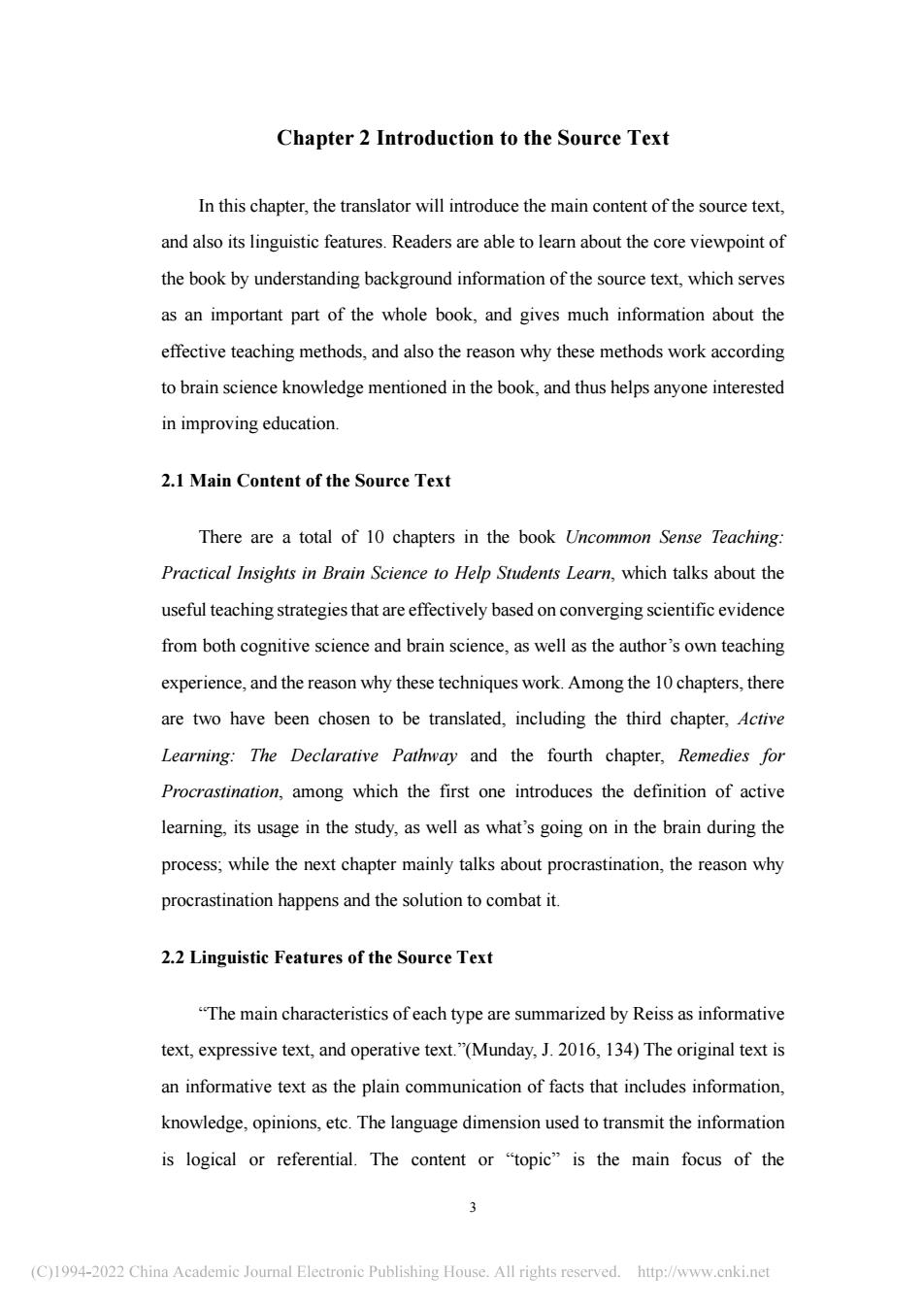
Chapter 2 Introduction to the Source Text In this chapter,the translator will introduce the main content of the source text. and also its linguistic features.Readers are able to learn about the core viewpoint of the book by understanding background information of the source text,which serves as an important part of the whole book,and gives much information about the effective teaching methods.and also the reason why these methods work according to brain science knowledge mentioned in the book,and thus helps anyone interested in improving education. 2.1 Main Content of the source Text There are a total of 10 chapters in the book Uncommon Sense Teaching Practical Insights in Brain Science to Help Students Learn,which talks about the useful teaching strategies that are effectively based on converging scientific evidence from both cognitive science and brain science,as well as the author's own teaching experience,and the reason why these techniques work.Among the 10 chapters,there are two have been chosen to be translated,including the third chapter,Active Learning:The Declarative Pathway and the fourth chapter,Remedies for Procrastination,among which the first one introduces the definition of active learning,its usage in the study,as well as what's going on in the brain during the process;while the next chapter mainly talks about procrastination,the reason why procrastination happens and the solution to combat it. 2.2 Linguistic Features of the Source Text "The main characteristics of each type are summarized by Reiss as informative text,expressive text,and operative text."(Munday,J.2016,134)The original text is an informative text as the plain communication of facts that includes information, knowledge,opinions,etc.The language dimension used to transmit the information is logical or referential.The content or "topic"is the main focus of the (C)1994-022 China Academie Joumal Eleetronie Publishing House.All rights reserved.http://www.enki.net
3 Chapter 2 Introduction to the Source Text In this chapter, the translator will introduce the main content of the source text, and also its linguistic features. Readers are able to learn about the core viewpoint of the book by understanding background information of the source text, which serves as an important part of the whole book, and gives much information about the effective teaching methods, and also the reason why these methods work according to brain science knowledge mentioned in the book, and thus helps anyone interested in improving education. 2.1 Main Content of the Source Text There are a total of 10 chapters in the book Uncommon Sense Teaching: Practical Insights in Brain Science to Help Students Learn, which talks about the useful teaching strategies that are effectively based on converging scientific evidence from both cognitive science and brain science, as well as the author’s own teaching experience, and the reason why these techniques work. Among the 10 chapters, there are two have been chosen to be translated, including the third chapter, Active Learning: The Declarative Pathway and the fourth chapter, Remedies for Procrastination, among which the first one introduces the definition of active learning, its usage in the study, as well as what’s going on in the brain during the process; while the next chapter mainly talks about procrastination, the reason why procrastination happens and the solution to combat it. 2.2 Linguistic Features of the Source Text “The main characteristics of each type are summarized by Reiss as informative text, expressive text, and operative text.”(Munday, J. 2016, 134) The original text is an informative text as the plain communication of facts that includes information, knowledge, opinions, etc. The language dimension used to transmit the information is logical or referential. The content or “topic” is the main focus of the